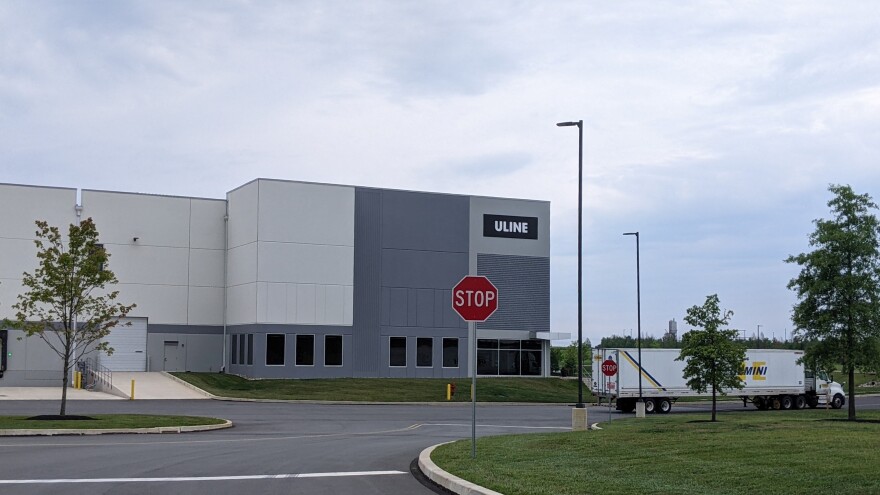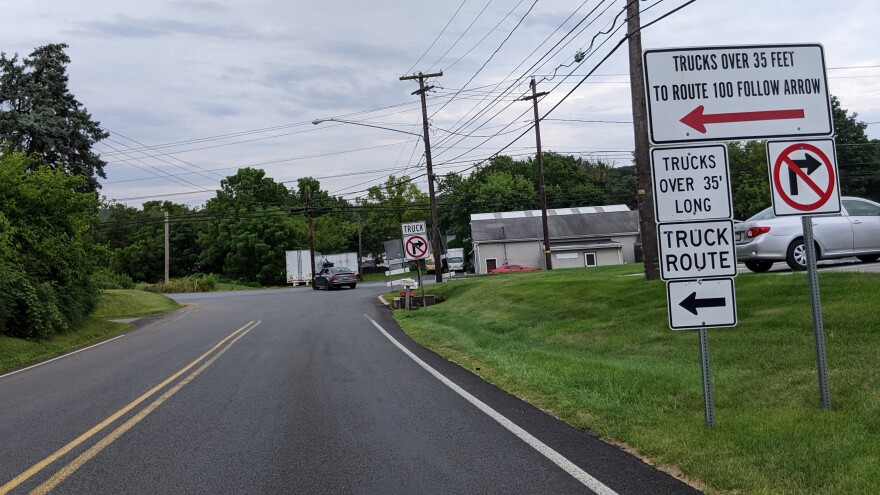LOWER MACUNGIE TWP., Pa. — Battles over warehouses are nothing new, as those living in Lower Macungie can attest.
A 2010 agreement between the township and Jaindl Land Co. diverted plans for a nearly 700-acre quarryin Lower Macungie Township in favor of a mix of residential, commercial and industrial development.
Within just a few years, by 2014, that agreement resulted in 3 million square feet of warehouse space being proposed on the land. Today, many warehouses can be seen there and nearby in Lower Macungie, near the Alburtis border.
In the decade since the business park’s approval and related legal battles with the developer, the township is eyeing a development future beyond large warehouses even as proposals still come in for other parts of the Lehigh Valley.
Township officials say it’s the result of a long process to restrict additional warehouse proliferation, even as approved projects on industrial parks and related infrastructure have been completed.
"The township has done its part. We fulfilled the land use obligation. We can move forward and look at other uses," said Nathan Jones, Lower Macungie Township director of planning and community development.
Lower Macungie is the third-most populated municipality in the Lehigh Valley. It is now being pitched new types of proposals, such as theJaindl-led Lehigh Valley Town Center and commercial development along Hamilton Boulevard.
Large warehouse and logistics centershave been the bane of resident groups and activists throughout the Lehigh Valley because of their environmental, traffic, agricultural and aesthetic impacts. While many see the development, jobs and property tax revenue as a benefit to the host community, others decry the toll taken on roads and other infrastructure.
Smart growth advocates often point to Lower Macungie for its success in managing the influx of development. But why has that worked there as others are caught up in controversial developments, disappointments or protracted court fights?
Municipal officials interviewed for this project repeatedly emphasized the limitations local governments have in Pennsylvania to control development. That’s because local governments must adhere to the Pennsylvania Municipalities Planning Code (MPC), a document originally passed in 1968 with limited revisions since.
Under the levers of control municipalities have, if zoning permits certain types of use, there are limitations on local government to stop a property owner from developing.
At the same time, when a project comes before a local government, there are often limited options communities have in demanding help to accommodate the impact on infrastructure, such as road widening, beefing up fire equipment resources and managing traffic flow.
“Pennsylvania is a right-to-develop state,” Jones said. “State law is much different than that of New Jersey or New York, or certainly anywhere up in New England. The land use law is written in favor of the property owners’ rights and their right to either develop or utilize their lands.
“You can't say no to something and vote it down just because you don't like it.”
What can local governments do?
Ron Beitler is a Lower Macungie resident-turned-activist who was elected as a township commissioner and then a Lehigh County commissioner.
When he saw warehouse proposals for Lower Macungie, he and others started to push back.
He argued the amount of jobs per acre large warehouses provided, along with the expensive infrastructure and drain on emergency services, limited the township’s tax revenue compared to other forms of development.
“Everyone agrees on that, you know, and you can't have the solution be to just continue recklessly developing your township to gain more property tax base,” Beitler said. “Like there has to be a better way.”
Beitler’s path from activist to township commissioner in 2013, to county commissioner in 2021, started at the time those warehouses were first proposed in Lower Macungie. (David Jaindl, owner and president of Jaindl Farms, which includes Jaindl Land Co., declined interview requests.)
Beitler said it was a steep climb to learn the complications of the state’s municipal planning procedures, the limitations of what can be done, and the power of established laws like local zoning ordinances.

“We got a very late start, but I can't think of anyone who got more aggressive earlier than us,” Beitler said. “We were kind of the ones that said ‘Enough,’ and then started employing these tools.”
Beitler said Lower Macungie deployed several techniques, managing over-development concerns with a playbook of:
- Tax-funded farmland preservation;
- Developing a multi-municipal plan;
- Updated zoning;
- Updating the municipality’s official map;
- Working with developers to seek higher-quality projects;
- Raising property taxes, with breaks and exclusions to owner-occupied residential homes.
“We understood what the toolbox was, and then we threw all the strategies up against it,” Beitler said.
He said adjusting property tax millage was to "ensure fairness" by collecting more revenue from impactful developments like warehouses while lowering the tax burden on many residential property owners.
Plan with partners
To stay in line with rules for municipal development, local governments have to zone for every conceivable type of use in their community, according to officials like Jillian Seitz, chief community planner for the Lehigh Valley Planning Commission.
Landowners may challenge a zoning ordinance’s validity if they believe the ordinance prohibits or restricts their use or development of land.
Not only that, but Pennsylvania case law requires that zoning ordinances cannot wholly exclude land uses based on constitutional property rights.
“It's landowners’ rights versus what you can regulate as a municipality,” said Scott Lipson, a Lehigh University professor and attorney at Norris McLaughlin.
The only exception, according to Becky Bradley, executive director of the Lehigh Valley Planning Commission, is when municipalities take part in a multi-municipal comprehensive plan.
Said Jones: “If you are not in a multi-municipal plan, you cannot exclude a use — you have to find a place for it.”
That’s why Lower Macungie worked to update the Southwestern Lehigh Regional Comprehensive Plan, coordinating with other municipalities — Alburtis, Macungie and Emmaus boroughs, and Lower Milford and Upper Milford townships.

The plan was finalized in 2017 and focuses on maintaining farmland and recognizing the limitations of rural areas. It plots industrial development uses primarily along Lower Macungie’s access to state highways, and keeps it away from the more rural and less developed Upper Milford and Lower Milford townships.
“A lot of our communities are dealing with outdated codes that didn't have modern language,” Bradley said.
“And we've been working with them to try to get them to update their code and sometimes you have a situation like [Lowhill Township] where they just didn't do it.”

But the plan itself is not legally binding to what can be built on a specific plot of land – each municipality has to update its zoning ordinances, following the guides established by the comprehensive plan.
The power of zoning
Zoning ordinances are what allow or disallow certain types of developments in a municipality.
Updating a zoning ordinance can be a lengthy process, involving public hearings and legal complications. But ultimately it’s what many activists and officials note is the most powerful tool to reshape and govern land use.
In 2017, Lower Macungie – by then with a motivated Beitler and current board President Brian Higgins as commissioners – appointed new members to the township’s zoning hearing board and updated the township’s zoning regulations.
Those updates removed warehouse uses from remaining industrial zones that weren’t already affected by proposed developments, such as the Jaindl warehouses.
The township also engaged in what Beitler called "surgical updates," such as adding conditions to certain uses.
Doing so also comes with risk, however. The required public advertisement of zoning changes ensures that property owners can submit an application for a development before changes are approved. They could be “grandfathered” – allowed under the zoning even after the updates pass.

"The landowner is always at an advantage because the township following [the Pennsylvania Municipalities Planning Code] in the municipality, city, borough, township, whatever - has to follow the rules. So you have to advertise, conduct a hearing," Beitler said.
"The landowners can fairly quickly conjure up a bare-bones plan and submit that and grandfather, right? So you're at every disadvantage."
Beitler and other officials said it can also be difficult given the state's requirement to provide for every conceivable use somewhere within the township, outside of multi-municipal plans.
"It all revolves around zoning," said Scott Bieber, a member of the smart-growth group Friends for the Protection of Lower Macungie and a former Morning Call reporter. "All the power's in zoning. The sooner townships realize, the better."
Since 2015 alone, Lehigh Valley Planning Commission figures show 44 million square feet of industrial and warehouse space has been approved in Lehigh and Northampton counties — the equivalent of more than 1,000 acres.
Bieber writes on Facebook and in op-ed pieces, advocating for municipalities to tackle updates to their zoning to remove warehouses from undesired locations — sooner rather than later. He said most industrial zones in the area permitted warehouses, not anticipating the boom of the past 15 years.
"They got caught with their pants down with their zoning laws," Bieber said. "Most of our zoning codes, regarding their industrial zoning codes, were adopted really before the warehouse boom began.
"Then all of a sudden the warehouse boom began because all these industrially-zoned areas were allowing warehouses. They were easy to get approved. You couldn't stop them because the zoning allowed it."
Preserving farmland
An official map may seem at first glance just a formality, marking things like roads, trail networks, parks and plans to expand each of these.
But a provision in the state municipal planning code allows for a key tool that some like Lower Macungie have leveraged to limit unwanted forms of development.
Land can be designated for open space, farmland preservation or other municipal uses – if the municipality can afford it, that is.

Official maps allow a municipality the opportunity to mark areas of land that they intend to reserve, allowing for a period of one year for the local government to negotiate the acquisition of the property.
“That's how we've gone about preserving at this point over 1,000 acres of farmland that could have otherwise been developed," Jones said, praising the quality of the region’s soil and arguing the need for local produce.
To fund the effort, Lower Macungie adopted an open space tax following a voter referendum in 2021 – a step now being followed by others seeking to preserve land.
Both the township and Lehigh County have open space and farmland preservation programs. Lower Macungie updated its official map last year, targeting further land preservation.
The impact of activism
What about local residents who want a say? What impact can they have?
"It is just a fact that most citizens know very little about what's going on, and really don't care until it gets in their backyard,” said Robert Rust, an attorney who represented efforts against warehouse development in Lower Macungie and previously sat on the township planning commission.
“And then it may be entirely too late."
Rust said public pressure and presence at public meetings can influence officials.
But to make a more significant impact, Rust says local residents can band together like the Friends for the Protection of Lower Macungie — a group he represented.
Once formed, Rust says, citizen advocacy groups have to know what to ask for, and be strategic.
“A small group of citizens, well-organized and committed, who can take advantage of their networks, can bring a lot of pressure,” Rust said.
“Unless you have a corps of knowledgeable, committed people that are willing to lay out a plan and to work the system so to speak, the citizen is almost always going to be late."
According to Bieber, the tools that work are in the hands of elected officials, but it can be a resident group like his that can actually influence them to use them.
"The people have to put the pressure on elected officials to promote land preservation wherever they can and to resist warehouses wherever they can,” Bieber said.
“And the only way you're going to resist the warehouses is by revising the zoning codes, where warehouses can be located."
Other tools
Jones and others noted that given the limited levers municipalities have, fostering good relationships with developers can be beneficial toward getting greater concessions, such as paying for infrastructure improvements and beautification.
Trammel Crow Co. has proposed and built several warehouse projects in the Lehigh Valley. John Pollock, Principal at the company, said it values working closely with local municipalities and state agencies.
“Opposition has not necessarily made us less inclined to develop in areas that are by-right for industrial development,” he said, “though we are taking added steps to work with municipalities to address any reasonable concerns from residents.
“The best way to do this is to treat the relationship between developers and municipalities as a partnership, in which case municipalities are more likely to obtain offsite contributions or other unique agreements with developers.”

Jones added those relationships also need to extend to PennDOT, other agencies and business owners.
He said an option Lower Macungie may encourage developers to use is rail freight lines, like those Norfolk Southern operates near the large warehouse park in the southwest of the township.
“For numerous years now we have industrial, commercial, office, residential, [and] open space,” Jones said. “And by having that balanced use of land, it's good from a quality-of-life perspective, [and] it helps from a tax perspective for the benefit of the residents as well.”
Lower Nazareth Township
Lower Macungie is not alone. Other municipalities have caught on to managing development that once threatened to overrun communities and their wide open spaces.
Lower Nazareth Township, in Northampton County, sits close to Routes 22 and Route 33, which in turn provide easy access to Interstate 78.
With the township’s public sewer and water, Township Manager Lori Stauffer says it’s a recipe to make it a “very attractive place” for commercial and industrial development. That includes a multitude of large warehouses.
“Over the past 15 to 20 years, we've seen numerous warehouse proposals come in,” Stauffer said. “I believe the last count we have is 25 warehouses within a 14-square-mile radius."
She says the township has about 9 million square feet of warehouses – equivalent to the amount of preserved farmland in Lower Nazareth.

Stauffer said she is not aware of buildings that double as significant manufacturing operations; most of the buildings constructed are focused on logistics operations.
The developments have brought positives – convenient access to commercial goods and helping to provide a healthy tax base for the Nazareth Area School District.
But the influx of traffic and tractor-trailers have added stress to roads and residential areas, she said.
“It comes to a tipping point where – how much are you willing to not pay real estate taxes and you're going to deal with the commercial and industrial development?” Stauffer said.
As a result, the township is following the playbook others like Lower Macungie have followed, using certain controls as it has continued to receive applications for new warehouse developments.
“We have to know that this is not about anti-development, it is about smart growth,” Stauffer said.
“My board looked at everything starting back in 2019, and started approaching it toward the perspective of ‘We need to start preserving our agricultural resources in the community,’” she said. “Because, unfortunately, once farmlands are developed there's no more farming.”
Lower Nazareth residents have experienced what has plagued Alburtis Borough and others, with trucks often veering into residential areas, causing damage and headaches for people who live there.
“They are constantly on roads that are marked no trucks,” Stauffer said. “They're constantly in residential areas. It's just taxing because our police department constantly has to monitor it.
“They're always catching trucks in no truck areas. So it creates an expense for us. It distracts our police department from other things they could be doing because now they've got to babysit the tractor trailers."

Like Lower Macungie, Lower Nazareth has taken several steps – starting by adopting an official map in 2020, with properties identified for development-rights acquisition. Following a 2019 referendum, the township started raising more money through a boosted earned income tax focused on open space preservation.
"Shortly after that, my board embarked on the idea of updating our zoning ordinance, which was incredibly antiquated – it was over 20 years old,” Stauffer said. She said the focus is on keeping large industrial and commercial development to the outskirts of the township instead of encroaching onto residential neighborhoods.
In February 2023, an ordinance removed warehousing as a permitted right by use in the township’s light industrial district.
Even so, Stauffer said, the speed with which local government acts can be significantly outpaced by the ability of developers to keep coming – and the impact on infrastructure keeps growing.
Stauffer says the cost to repair roads is “astronomical,” and notes making improvements to intersections and roads can be a slow process, such as a current PennDOT project to widen Newburg Road at Route 191.
In Lower Macungie, this manifested in the stalling of the Sauerkraut Lane Extension near a large warehouse park, contributing to trucks getting stuck in and causing property damage in the dense residential areas of neighboring Alburtis.
Over the long haul
Stauffer also says it takes time to save money to bid for a plot of land for farmland preservation, given the financial resources of developers.
“If you have property owners who all they're looking at is ‘I want the biggest dollar amount that I can get out of this,’ we don't stand much of a chance," Stauffer said.
In Lower Macungie, Jones said despite adjustments and development controls, the story of warehouses is still being written. He says many of the buildings in his township also contain manufacturing uses in addition to logistics management.
"Just as the SteelStacks (in Bethlehem) got redeveloped after steel manufacturing was over, what these structures are used for currently might not be what they're used for 50 or 100 years from now,” Jones said.
“I would encourage everybody to think what is the long-term use of these — will they remain up forever? Will they be taken back down and moved back to active agriculture? Will indoor agriculture occur in them? Will it be manufacturing in perpetuity?
“You just need to make sure that you have a long-term plan for them, not just the short range, because what we're seeing right now with our economy and the shop-from-home trend in 50 years could be entirely different.”
RELATED STORY: How some in Harrisburg are responding.
COMING TOMORROW: END OF THE BOOM?
For much of the past decade, warehouses sprang up like dandelions across the Lehigh Valley. While the market is by no means in free fall, experts say it has undeniably slowed since 2022. Is it a lull, or has the warehouse boom come to an end?





